#yamato hira
Explore tagged Tumblr posts
Text
Haruno Sakura & Team 7, Yamanaka Ino, Sai, Shizune, Tsunade, Hatake Kakashi, Yamato, Uzumaki Naruto
post-Tenchi Bridge mission | canon divergent | one-shot
A Straight Way series: part 1
The problem with being well-liked, dependable, and in a pretty public position, is that people will notice you're missing sooner rather than later.
#naruto#haruno sakura#yamanaka ino#sai#shizune#tsunade#hatake kakashi#yamato#uzumaki naruto#my writing#hira writes naruto#fic: meanwhile in konoha#fic series: a straight way#okay i lied#there will be fic this weekend#just not saso//saku because i'm not in the right mindset to tackle anything heavier than this type of lighthearted gen writing#but i needed a distraction so. here we are.#hope you enjoy!
1 note
·
View note
Text
Random QL Superlatives: 2024 Edition
This list is gonna contain qls (and a few kdramas) I’ve watched this year, rather than the qls that were released this year.
Best Hosaka: Namgoong Shiwoon, Light On Me
ICYMI, I am obsessed with Hosaka from I Cannot Reach You, for his complete disdain for miscommunication, his incredible radar for bullshittery, and his otherworldly ability to not-so-gentle-parent bl boys into talking to each other. Every BL should have a Hoska. A Hosaka is a crucial part of a healthy BL ecosystem imo. So this year’s Best Hosaka Award goes to.. Namgoong Shiwoon!

Namgoong is kind yet firm in his opinions (and boyyy does he have them in a bushel and a peck), goofy in physicality yet measured with his words, and an all-around stellar friend. He would figure out the exact ways you’re ruining your life before you’ve even had a chance to emerge from the mental rubble, and will meet you with a detailed presentation on how to fix everything. Get a Namgoong for your life and listen to them for the best results!
Favorite Signature Move, Kiyoi tackling Hira, Utsukushii Kare 2 and Utsukushii Kare: Eternal
Kiyoi losing his patience with Hira and tackling him to the ground so he can get in his face and scream to get information out of him was simultaneously hilarious and sad.


Most Ineffective Defense: Sangwoo and His Lil Desk Divider, Semantic Error

I am still laughing at how Sangwoo believed with his entire precious heart that putting up a foot tall, easily removable physical barrier is gonna deter my man Jaeyoung, menace extraordinaire and dedicated Sangwoo-annoyer. Boy, did you even wanna try?
Saddest Sex Scene: At 25:00, In Akasaka
I was already heartbroken when Hayama and Shirasaki tried, failed, and emotionally devastated each other by attempting to “rehearse” for their intimate scene the previous night, but the filming of the actual scene took the pieces of my shattered heart, stomped on it, and then set it on fire. The aborted pinkie touch should be made illegal due to the amount of pain it inflicts on the masses.

Favorite Wholly Unrealistic Teenage Boy, Hasegawa, Oppan
I love this boy with all my heart and soul. What a mature little teenage noodle. The writers must’ve conceived his character by pouring all the good stuff they want to see in a baseball-jock teenage boy into a beaker, and out he emerged, Powerpuff Girls style.

Best Use of Strong-Independent-Women Money: Lee Mi Na’s Collection, Hit The Spot
I adore this woman for many things. Her friendship with Hee Jae. Her standards for men.

But most of all, I adore her for the things she spends her money on.


What an icon.
Best Righteous Anger: Ryunosuke, Tokyo In April Is…
I am always a big fan of characters who are mad for the right reasons and are not afraid to show it. Ryunosuke watched his friend carry this unbearable guilt around for years, and was rightfully mad at Kazuma who he assumed knew what had happened to Ren. And when he realized that Kazuma did not know, Ryunosuke sets his anger aside and tells Kazuma. I am part of the Ren Protection Squad and Ryunosuke is our leader.

The Cameo That Inspired The Loudest Scream: Madea Kentaro in Utsukushii Kare: Eternal
My earnest, precious son Yamato from I Cannot Reach You showing up in the middle of Hira and Kiyoi’s patented messiness? The scream I scrumpt, y’all.

Bestest Best Friend: Joon Pyo, The Eighth Sense
Joon Pyo! He got the fuck out of his own room for the night so his childhood best friend can get some. Ji Hyun better protect and cherish him at all costs.
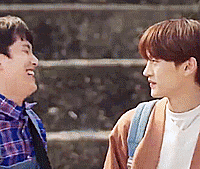
Most Precious Gift To The World: Fujita-san and Kasuga’s conversation, Tsukuritai Onna to Tabetai Onna Season 2
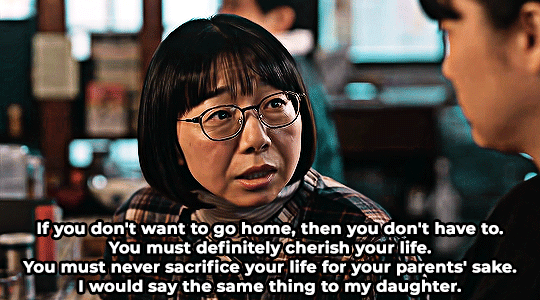
Asian daughters fighting the intergenerational trauma demon everyday just.. get to have this? To watch whenever we want and draw strength from it? And feel the shoulders of the other daughters (and mothers) also fighting their fight, standing right beside us, fighting, and living, and thriving? What a blessing.
Wisest Wisdom: Pie’s Post-Breakup Advice, The Trainee

Heartbreak is temporary. French Fries are eternal.
The Swooniest Gwenchana: Ji Hyun, Happiness

Did I make up a whole category just because I needed to put his face on this post? Yes.
This year has been, amongst many things, undeniably fun. Tag me in your superlatives lists, and I will see y’all in the next one!
Tagging the peeps: @lurkingshan, @bengiyo, @happypotato48, @wen-kexing-apologist, @starryalpacasstuff
#bl superlatives 2024#light on me#utsukushii kare#utsukushii kare 2#utsukushii kare: eternal#my beautiful man#semantic error#25 ji akasaka de#at 25:00 in akasaka#ossan no pantsu ga nandatte ii janai ka!#don't care for an old man's underwear!#oppan#hit the spot#shigatsu no tokyo wa...#tokyo in april is...#the eighth sense#tsukuritai onna to tabetai onna#she loves to cook and she loves to eat#the trainee#tvn happiness#multi ql#kdrama#jdrama
89 notes
·
View notes
Text
Post 9 Gifs of Your Favorite Characters and Let People Guess Your Type
I was tagged by @thisonelikesaliens and @easterndelights
I like them and I can remember their name:

Ohara Yamato - I cannot reach you

Wei Wuxian - MDZS / The Untamed

Hira Kazunari - My Beautiful Man

Adachi Kiyoshi - Cherry Magic
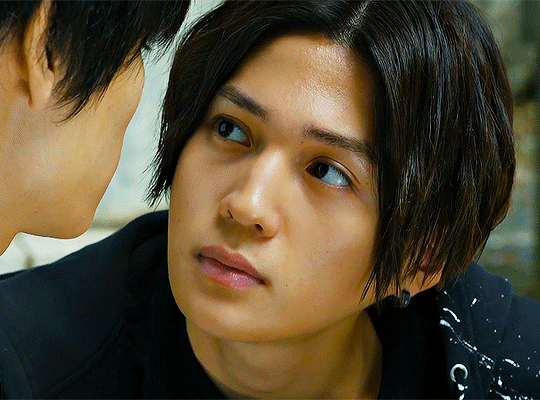
Kiyoi Sou - My Beautiful Man

Noh Shinwoo - Light on me

Gao Shide - We Best Love

Yang Taeseob - Life is Beautiful

Hayama Asami - 25 Ji, Akasaka de
Tagging @benkaben @watchthisqqq @theside-b @ellsieee if you want to join
17 notes
·
View notes
Text
Rose Recaps 2023 - Japan
So, because I have a hard time making big lists and choosing favourites, this my version of a superlative post, by country.
The one that had me at the first frame
If It’s With You | Kimi to Nara Koi wo Shite Mite mo
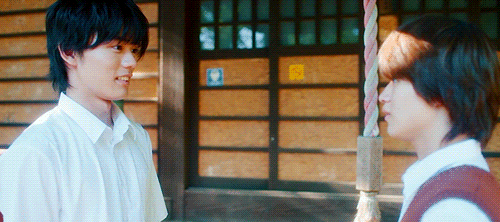
As soon as Amane appeared on screen I was gone. This damaged but confident boy had my heart from the beginning. But it was Ryuji that ended up with a bigger piece by the end. The way he saw Amane’s mask from the beginning and just went – “you don’t need to do that with me”. And the way he considered Amane’s feelings even when he wasn’t sure what to do or how to respond, or how he was feeling about all of it, was just beautiful to witness and at certain points kinda reminded of Ida.
Favourite Moment: Amane confessing and running away. Because visually it's so striking. The way he's running from the light that is Ryuji.
The one that was perfect and I never saw coming.
I Cannot Reach You | Kimi ni wa Todokanai

I think that by now at least some people know how I feel about Japanese BL. I love it so much. And for me it’s always about the characters. Whether they are the embodiment of chaos, like Aoki or they are just incredible complex and empathic humans like Ida. - Yes, I’m using Kieta Hatsukoi every chance I get- I just love the way all these characters are written and portrait.
I loved these 2 boys in equal measure all throughout the show. I might have a soft spot for Yamato, but that’s only because pining boys are my weakness.
Yamato’s back and forth in his own head about what to do would be annoying to me in any other show, but it was so well done, and we were privy to his thought process throughout that it just made me feel for him deeply. And Kakeru learning about Yamato’s feelings right away in the first episode was a great choice, because he gave the show time to make the reciprocity more believable.
Favourite Moment - The exchange of gifts at the door. I love the nervousness that the two of them are feeling in this moment.
The one where I gave in.
My Beautiful Man S2 & Eternal
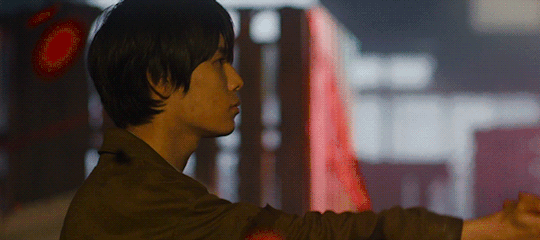
Confession time. This was not love at first season for me. I don’t argue quality overall and much less the acting of the show, but it just didn’t click for me.
There were some truly great moments in the first season but there was a disconnect between my heart and my brain. This happens to me sometimes. Like I watch something that is objectively good but it doesn’t reach me.
That all changed with the second season and the film. I finally connect with Hira. Don't ask me why, I don't fully understand myself, but it happened right at the beginning of the season. I think perhaps it was because I started seeing more from Kiyoi pov, because before I was absolutely clueless about what he saw in Hira in the first place. Sorry if that sounds harsh.
I don't blame the show for this, as I said, I think all the elements are there, it just didn't connect for me.
Also, the film was gorgeous to watch. Several moments (specially the sequence where the gif is from) were so well shot and edited that I'm happy I went in already with a positive mindset.
Favourite Moment: The one from the gif. I'm a sucker for a drastic visual change when the moment calls for it.
The one that had me question if watching it was good for my mental health.
Tokyo in April is | Shigatsu no Tokyo wa
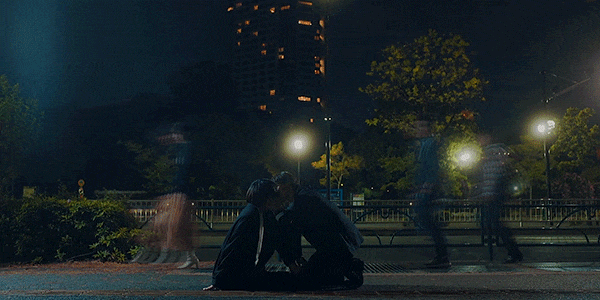
Ok. I love this show. I love Ren. But this was a hard watch for me. Every week I had a struggle between two sides of me.
- Don’t watch it. It will be sad and you will be sad because of it. - But the last one was sad so I need to watch it to see if there’s happy. - Why not just wait? - Because I started already, so now I can’t wait. - But in this case binging is best. Cause for sure the ending is happy so you won’t be sad for long. - Yeah, but I need to see more now. And there’s a new episode waiting for me. - Fine. Just press play. After the episode. - I really shouldn’t watch this one live. (all this repeats the following week)
It was beautifully acted, there were some outstanding moments, the past was as tastefully done as it could be given the subject matter, and in the end my heart of full, but slightly damaged with the process.
Favourite Moment: Ren finding out Kazuma had been looking for him.
The one with all the magic.
What Did You Eat Yesterday? | Kinou Nani Tabeta? S2
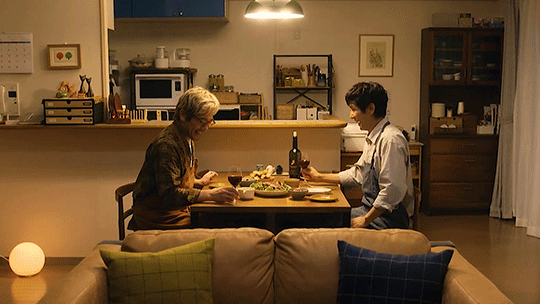
I already wrote how this show made me feel in another post. So I’ll just say this.
EVERYONE NEEDS TO WATCH THIS SHOW. NOW. If you haven’t, stop reading this and go. GO. NOW. Start.
There is magic here and you don’t even know.
Favourite Moment: ALL OF THEM. But really this one.

Shiro. Just Shiro.
Well, I'll try to write the next one in these next couple of days. Wish me luck.
Thanks for reading💜
#Rose Recaps 2023#kimi ni wa todokanai#kimi to nara koi wo shite mite mo#i cannot reach you#if it's with you#kinou nani tabeta#tokyo in april is...#shigatsu no tokyo wa#utsukushii kare#my beautiful man eternal#rose rambles
111 notes
·
View notes
Text
yamato crouching on the floor after getting those biscuits from kakeru, 'I'm so happy i could die' gave me such strong flashbacks to Hira i had to pause and lie down for a bit
#kimi ni wa todokanai#i can't reach you#yamato x kakeru#kashiwagi haru#maeda kentaro#aa mine#thingamabob
31 notes
·
View notes
Note
Who is your favourite OC?
Can you describe them? 🤭♥️
I have a lot but I'll separate them in categories or whatever it is spelled
Bungou Stray Dogs
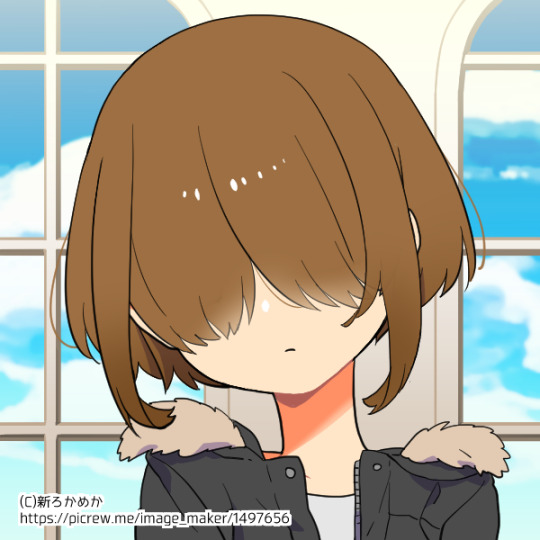
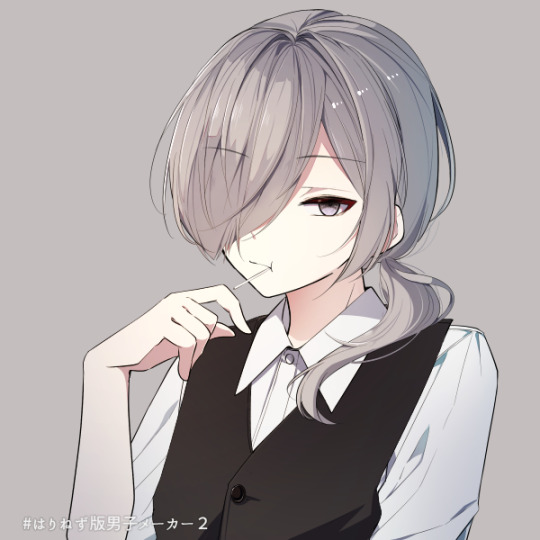
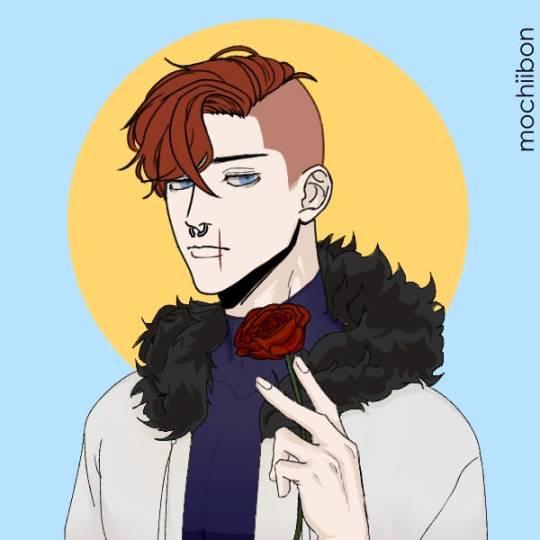
Makoto Dazai
Makoto Dazai is 8 months younger than Osamu Dazai
Being Ougai Mori's bodyguard, Makoto is in the Port Mafia even after what happened with Oda, he has always and will always stay on Mori's side. His ability makes him able to control rats
Makoto is a trans boy, autistic and blind, also Ougai Mori's height. Osamu is obsessed with him in a way that he overprotects his younger brother
Hiroki Maruyama
Covering his right eye because someone took that eye, Hiroki Maruyama is a 28 years old who shares Chuuya's height
Grumpy former trainer in a yakuza, nowadays works in a brothel but in an AU he's a teacher in a school. He's disabled not only because he sees through one eye that makes his life difficult, he has issues walking and is always using a cane
574
2 meters tall man looks scary but is actually extremely soft
Former trainer in a yakuza, now takes care of the daughter of the boss who died. He's a bodyguard, has always been a bodyguard and is in charge of giving the numbers to the people of his (previous) criminal organization
From 0 to 1.000.000, the closest it is to the 0, the stronger the person is with their ability/skill
Bungou Stray Dogs Beast

Gabriel García Márquez
Inspired in the author of the same name, he's from BSD Beast
He owns a restaurant (cat cafe) with his cousin Ángela Vicario and her husband Bayardo San Román. His ability is inspired in the book Chronicle Of A Death Foretold, he's the same age as Hirotsu
M. M.

Max Gómez
Protagonist of the first part of my original story. Max Multiverse
He's a grumpy teenager in that picture, and uh it's hard to explain his world but I hope the multiverse-thing give you an idea
He's 25% a OC self-insert, I started doing his story when I was literally 4 years old lol
Kid is the vessel of a powerful demon, mother abusive, doesn't know his biological dad is the brother of his dad, has an older brother... Max ended up in an asylum after burning his house with his family in, ended up doing a deal with the strongest demon of them all and bla bla bla
B. A. D.
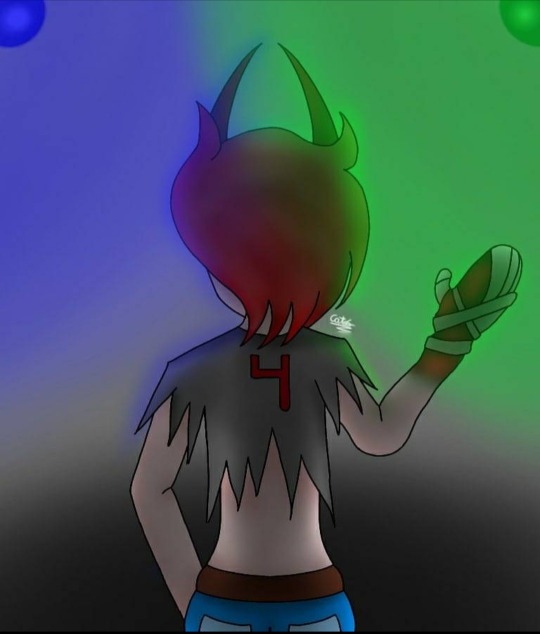
Jack 4
That draw is old as fuck but he's the Jack of universe 4, from the second part of my original story, Black And Demons
Jacks are demons that are the personifications of traumas in humans, the reason why they are traumas rather than the feeling of fear
Jack 4 is in charge of a place called «The Prison/Jail» where powerful and dangerous being are sent so the multiverse won't be destroyed. Oh and his right hand? Oh it's connected to the place he's also locked in and can't scape
BSD OCs inspired in authors excluding Gabriel García Márquez
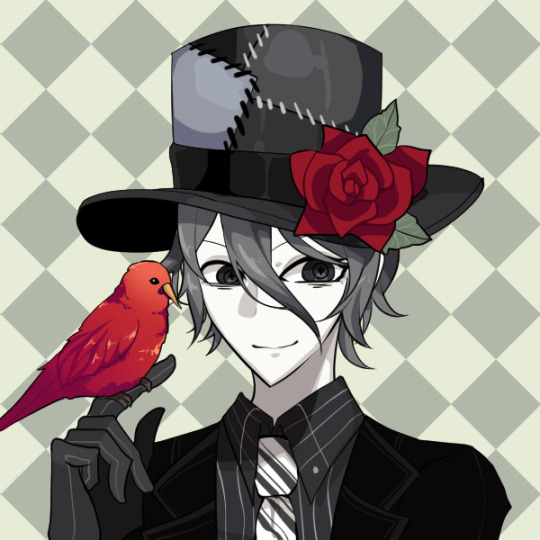
Egon Wolff
He's a homeless person inspired of two characters by Egon Wolff. El Merluza in Paper Flowers and China in The Invaders
Ranpo doesn't trust him and is afraid of him
Obey Me!
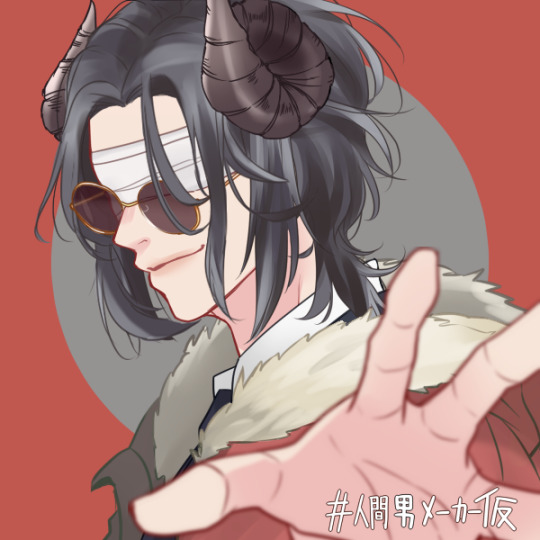
Zalgo
He's a demon and the personification of fear, inspired in the creepypasta of the same name, Zalgo
He covers his eyes because when people outside his dimension of chaos stare at him, start crying and shaking in fear extremely traumatized
He gets along with Diavolo, met his dad, Barbatos is his best friend and Lucifer doesn't trust him at all
Jujutsu Kaisen

Kiyoshi Hira
Yes the same picture of my profile picture without the cat ears is a JJK OC
Masamichi Yaga's best friend, Kiyoshi isn't a sorcerer or part of the Jujutsu world because he doesn't get along with the people in charge
Kiyoshi hates Gakuganji, Gojo is afraid of him, Kiyoshi had a wife but died because of Gauganji. Yamato is the name of Kiyoshi's only son
His cursed technique makes him able to control cursed energy just by talking, murmuring and screaming. He can extract cursed energy, absorb it, make it part of other living things, and can communicate with cursed spirits and all of it– Uh he almost destroyed the world one time but can't see in one eye and half of his body is paralyzed because of an accident
#adopted parents council#adopted parents council asks#makoto dazai#kiyoshi hira#jjk ocs#bsd ocs#obey me oc#ocs#b. a. d.#m. m.#real life authors#picrews
8 notes
·
View notes
Text
Utsukushii Kare's Flower Language
That one sudden bewitching moment of epiphany, when you suddenly figure out what these flowers are and mean.
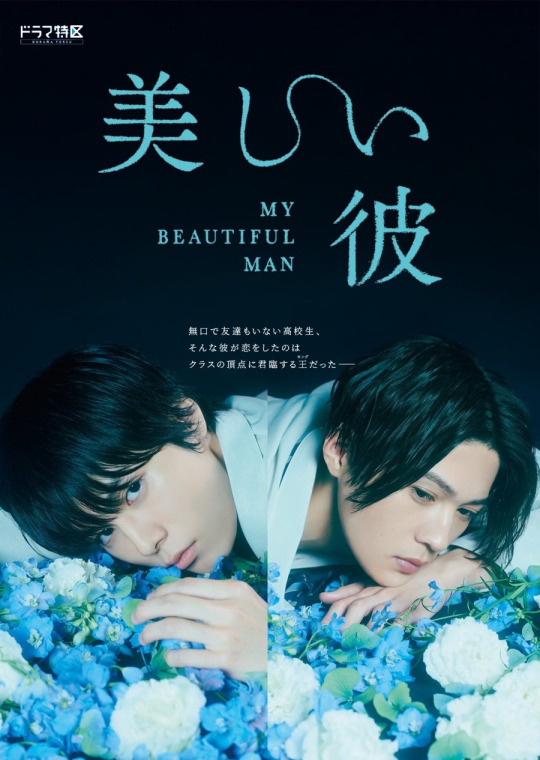
At first sight, I thought the blue ones might have been hydrangea, but after watching the series, that didn't seem to quite fit at all. (Hydrangea stand for capriciousness and ruthlessness.)
But the blue ones totally are bellflowers, are they?

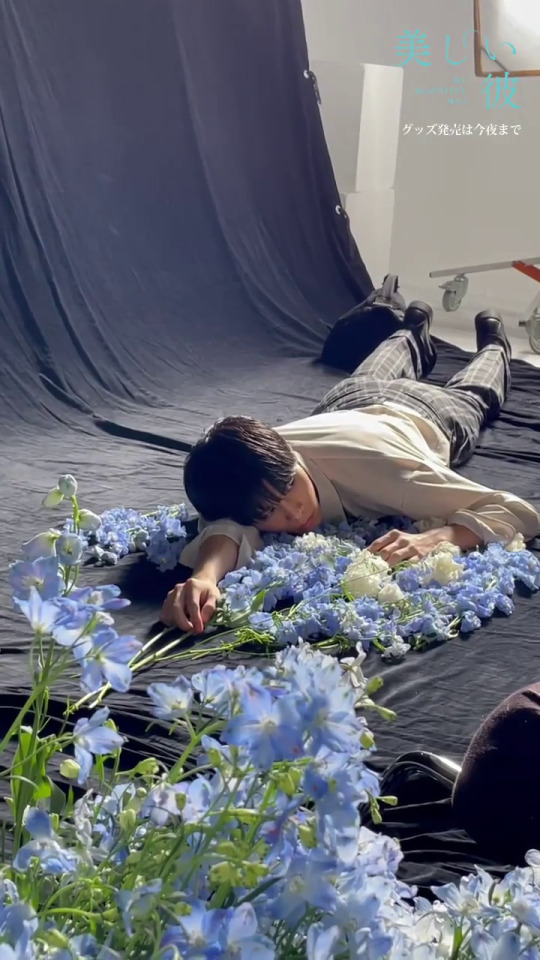
The Japanese flower language of bellflowers (ホタルブクロ, hotarubukuro) is "loyalty/devotion" and "justice" (忠実 & 正義).
This couldn't be more on the nose. (Not that it should be any surprise, with the show's music lyrics doing exactly that, too.)
(I'm almost inclined to wonder if the hydrangea vibes are maybe intended, as well. That blue filter reminds me a lot of that chilly damp tsuyu-melancholy sorts of a mood, and hydrangea are very much attached to that rainy season. The flowers also only show up in promotion materials, and just by first impression of the premise outline, the hydrangea meaning seems to be rather fitting.)
(Trivia: 蛍袋 is an alternate writing for hotarubukuro. It means literally "firefly sack". Which is a fairly interesting image all by itself.)
The white flowers sprinkled through the bellflowers seem to be white carnations.
The Japanese flower language of carnations (ナデシコ, nadeshiko) states "boldness", "pure love" and "faithfulness" as in fidelity to one's partner* (大胆, 純愛 &貞節).
Couldn't be more on the nose, too.
I just wonder a bit about the white part of them. I would have thought they might just signify purity even more, but seems like they have the additional meanings of "skillfullness/shrewdness" and "talent" (器用 & 才能).
(Maybe some foreshadowing on that Hira is good with studies and also gets picked up to be an assistant to some famed photographer in the novel sequel?)
* Nadeshiko are classically associated to the female stereotype of the strong-willed to almost stoic, but still utterly dependent and devoted wife. Which is why the traditional Japanese female beauty standard is also called "Yamato Nadeshiko".

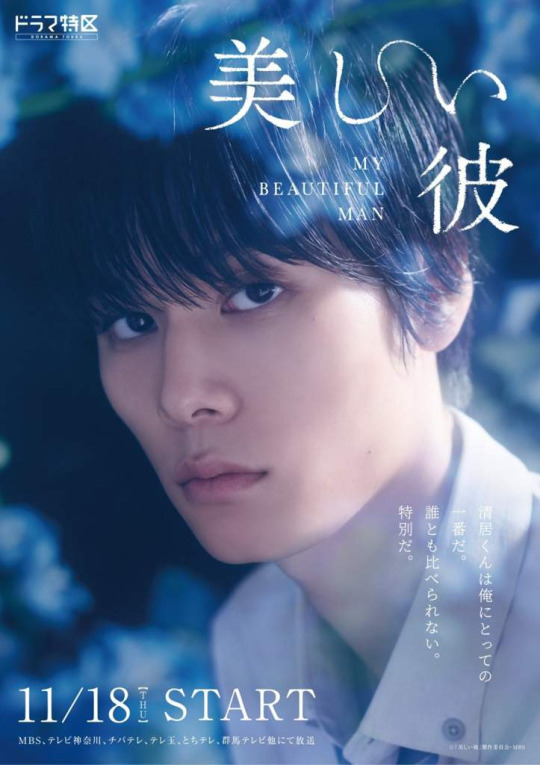
The bellflowers are far more predominately showcased in any case, though.
61 notes
·
View notes
Photo




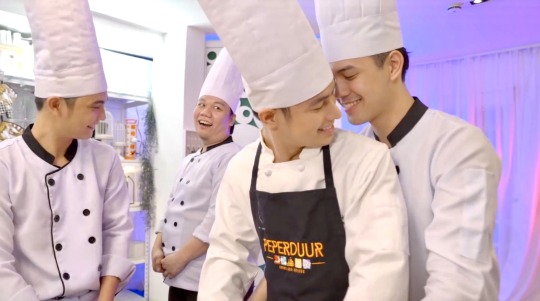
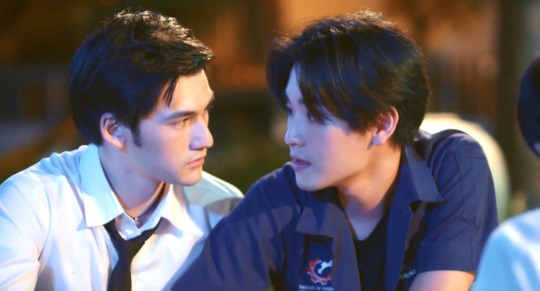
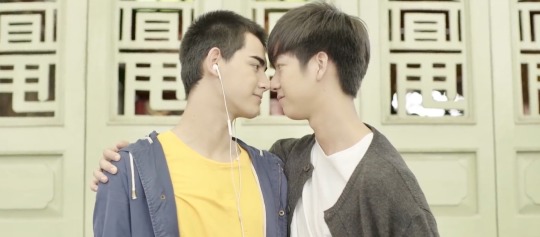


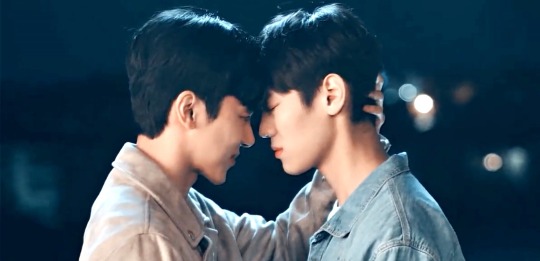
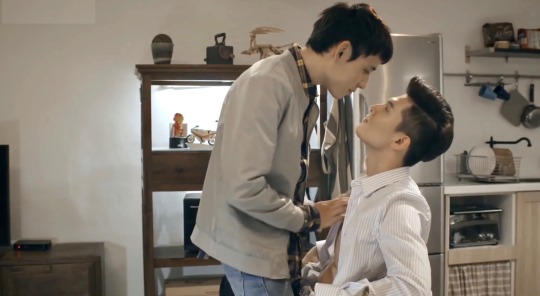

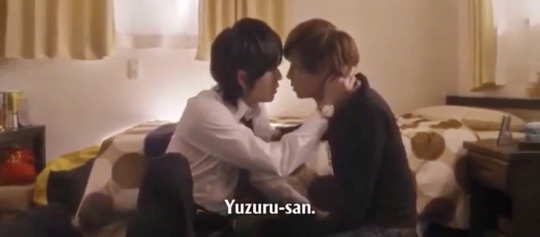
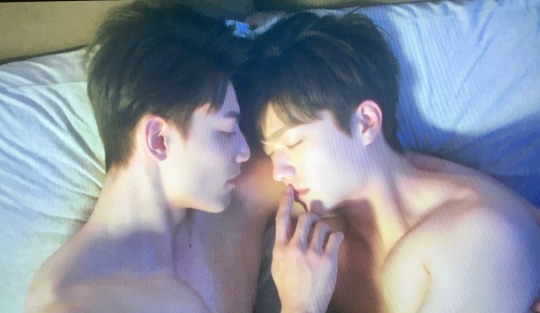


BL couples where there is no established seme/uke dynamic.
Hsia YuHao & Qiu ZiXuan in HIStory 2: Crossing the Line - Taiwan
Du & Phuc in Hay Rival, I LOVE YOU (somewhat less so in Monster in Law) - Vietnam
Win & Tops in Ingredients - Thai
Keen & Tum in A Chance at Love - Thai
Ace & Sky in My Day - Pinoy
Ram & King in My Engineer - Thai
Tee & Mork in My Tee - Thai
Mitsuomi Kozuka & Yamato Kumai in Restart After Come Back Home - Japan
Ai & Ni in Tonhon Chonlatee - Thai
In Soo and Min Sung in Wish You - Korea
TangYi & ShaoFei in History 3: Trapped - Taiwan
Paper & Fah in Second Chance - Thai
Seryou & Yuzuru in Seven Days - Japan
YuZhen & ShiLei in Be Loved In House: I Do - Taiwan (My original blog post on seme/uke was spawned because of these two)
JiWoo & SeoJoon in To My Star - although (you could argue that this is an example of an aggressive uke)
Pat & Pran in Bad Buddy - Thai (there’s discussion to be had tho, Pat acts the seme a lot)

So most BL is based on yaoi, and almost all yaoi was written with a seme/uke pairing. One character is the active pursuer (often conflated with masculine/top/Dom) while the other is the passive pursued (often conflated with feminine/bottom/sub). Before you say anything, yaoi conflates those three bracketed terms, not me. But then so does a lot of BL.
Here’s a analysis on seme/uke in BL.

In other words, these are heterosexually dysmorphic pairings where one dude takes on the “feminine” role and is usually also depicted as physically smaller, reluctant to agree to a relationship, scared of sex, blushing maiden, etc... The other dude takes on the “masculine” role and is usually also depicted as taller, richer, sexually demanding, as well as more muscled, aggressive, and successful (socially, intellectually, or otherwise).
I’m not gonna diatribe about how totally het and weirdly fetishizing this is, because ya’ll know that. (In order to get over it I just plug my ears, go la la la, and pretend these are all D/s relationships.)
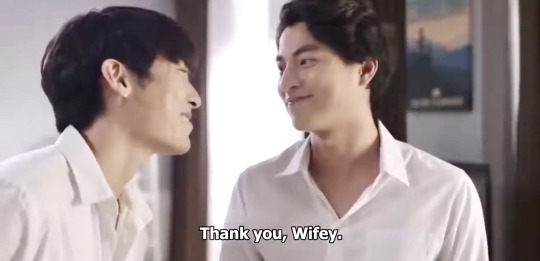
However, it does make me super delighted when I see a more honest portrayal of verse in BL.
So the above named couples are ones where the story never established who would be the dominant. Or where there is consciously no clear uke/seme roll assigned.
Full discussion on this matter here.
More on heterosexual dysmorphia, seme/uke assumptions and the damage it does to EVERYONE’S sex lives. Yes, even yours (if you have one).

MORE!
narrative where the character who is most intersted in pursuing a relationship (seme) is the main character
This character may act submissively or be dominant and aggressive about their pursuit in the old yaoi seme style, but is the clear POV either way.
Utsukushii Kare - Japan (fight me: Hira is a submissive with a humiliation kink but he is the seme)
Wish You - Korea (another one where the main character feels like a submissive to me, but acts as the seme of the narrative)
Love By Chance - Thai
Given - Japan
SOTUS - Thai
Restart After Come Back Home - Japan
Because of You - Taiwan
Life: Love on the Line - Japan
Craving You - Taiwan
Silhouette of Your Voice - Japan
Stupid Boys Stupid Love - Vietnam
HIStory 3: the BL that shall not be named - Taiwan
Maybe also qualify: Golden Blood, Tasty Florida, Kieta Hatsukoi.
narratives that do both: no seme/uke + there is a clear POV character who wants the relationship
This is probubly what you really wanted with the original question?
HIStory 2: Crossing the Line - Taiwan
Secodn Chance (Paper & Fah) - Thai
History 3: Trapped - Taiwan
Where Your Eyes Linger and Nobleman Ryu's Wedding are both generally open to debate.
(This is my shocked face that Taiwan and Japan show up the most.)
(source)
#HIStory 2: Crossing the Line#asianbl#asian bl#uke/seme#yaoi#damaging trope#problematic trope#romance trope#taiwanese bl#taiwan drama#korean bl#k-bl#Hay Rival I LOVE YOU#ingredients the series#A Chance at Love#my day the series#My Engineer#My Tee#Restart after Come Back Home#Tonhon Chonlatee#Why R U#fightertutor#wintops#acesky#skyace#ramking#teemork#morktee#TonhonChonlatee
288 notes
·
View notes
Text
Overhaul, Shigaraki, Hawks, Dabi one shot
so their kids basically, how many they would have, their personality, how they would look so ye
and god thank you guys so much for liking all of these, they rlly mean a lot!!!
Overhaul
Quantity: 4 (he want’s enough kids to lead the Yakuza when he passes)
Katsuo (kaht suh oooh)
Yamato (yah mah tou)
Itzuki (eet su keigh)
Noboru (no bou ruh)
Katsuo: He has Y/H color. He is the smallest and youngest of the 4 kids. He has bright golden eyes just like his father, and has dimples on both of his cheeks.
Personality: He’s extremely mischievous and loves to mess around with the henchmen. When he isn’t causing trouble he is helping others.
Quirk: Heal
Yamato: He has a mix of both your hair colors, it’s basically just auburn hair with your hair color streaks
Personality: He’s adorable. Just pure adorable, though his personality isn’t. He loves to tease and is the cockiest child ever, when thing’s don’t go his way he screams and cries, which sorta reminds you of Overhaul.
Quirk: No Quirk
Itzuki: He is just pure adorable, and so is his hair color. Itzuki loves to play with his toys, he is always by Overhauls side, just gazing up at him like he’s a god. He likes to watch his brother, later on he develops germaphobe tendencies. Thank god Overhaul knew exactly how to treat em.
Personality: Calm, quiet, extremely intelligent for his age. He rather gaze around the world with round eyes rather than explore it likes his brothers do.
Quirk: It’s very similar to Overhaul’s quirk except he can only detach limbs, not even rebuild them.
Noboru: The eldest child of them all. He looks exactly his father, and acts like him, calm stoik, he rarely shows emotion, but he does not like hanging around his father, he’d much rather figure out how to play House with his siblings
Personality: very very calm, he doesn’t talk much (only with his siblings), very charming and good looking, very kind when he wants to be, has a bit of sass, overall a good kid
Quirk: He heals people with his quirk in an Overhaul type of way.
Shigaraki
Quantity: 1
Akko: Just a bundle of pure joy. He loves to waddle around the bar and play with everyone, even with Mustard. He has baby blue hair, just likes his fathers, it has your hair texture, and everyone loves playing with his hair. He has one red eye, the other one is your eye color. You and Shiggy just love that.
Personality: Loud (he loves to squeal and giggle 24/7), adorable, he likes to do things on his own, but loves for everyone to be paying attention to him, a bit of a stuck up, the star in the bar.
Quirk: He can create a barrier, like a force field, and if anyone touches it they turn to ash.
Dabi
Yall not having kids. He does not want kids till he leaves the bar, or if its just unexpected, then yall only having 1 kid and it’s gonna be a secret or else Dabi will skin you alive. He doesn’t want to put his kid at risk.
Quantity: 0-1
Hira: girl, she has long white hair, similar to Fuyumis, with red streaks. You were confused at first because neither of you have natural white hair, but then Dabi revealed his identity and then it made sense. She has Dabi’s eyes and your face shape.
Personality: She is a pretty cocky kid, she loves your guyses attention, she can be pretty mysterious, and she’s great at keeping secrets and lying.
Quirk: Her flames heal people rather than hurt them. When Dabi found out he broke down it tears. LIke it was hard for him to comprehend those similar flames that destroyed him could bring so much beauty to the world.
Hawks
Quantity: 2 (After the second you just said no to more kids bc the brith is hell)
Mareo
Miyo
Maero: He’s very cute, he has his fathers wings, they are a brownish color, just likes Hawk’s fathers, and he has his grandpas hair, but he has your eyes. When Hawks first saw him he just sat there and stared at the kid for 3 hours, while the kid kept whimpering and curling into him.
Personality: Silly, goofy, aloft, adorable, he loves to go on flights with his father all the time.
Quirk: He has wings which can set ablaze, kind of like Hawks and Dabi’s love child except it’s a brown flame (your quirk is healing, so whenever you heal someone a small flame bursts on the tip of your finger, and u use that to heal ppl)
Miyo: He also had wings, except there white with red streaks, there slightly larger than his brothers, so he constantly flaunts them and says he’s the superior child, though Mareo can beat him in speed.
Personality: Confident, silly, loves chicky nuggies, likes to sit down all day, flies a lot.
Quirk: Fierce wings, just a more advanced version.
that took longer than I expected, hope u all enjoy it <3 <3 <3
#boku no hero academia hawks#shigaraki tomura#dabi#overhaul#hawks x reader#shigaraki x y/n#dabi x you#kai chisaki x y/n#pregnant#kid#headcanon
219 notes
·
View notes
Text
Glossary of Japanese swords
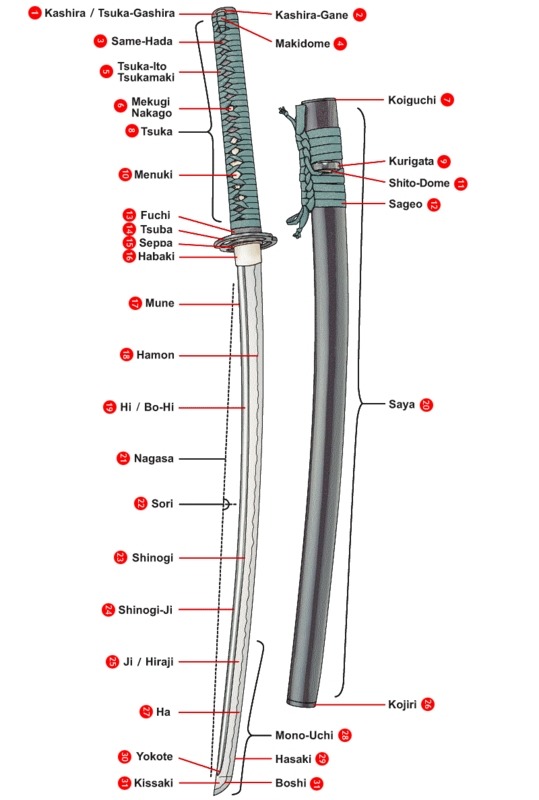


A
ashi (足, “leg”) - thin line that runs across the temper line (hamon) to the cutting edge (ha).[1]
ayasugi-hada (綾杉肌) - regular wavy surface grain pattern (jihada). Also known as gassan-hada after the name of a school which usually produced swords of this type.[2][3]
B
bokutō (木刀) - an authentically shaped wooden (practice) sword (or other bladed weapon).
bōshi (帽子) - temper line (hamon) of the blade point (kissaki). (see image) (also see ko-maru)[4]
C
chikei (地景) - black gleaming lines of nie that appear in the ji.[5]
chirimen-hada (縮緬肌, crape grain pattern) - distinctly visible mokume-hada with a clearer steel than in similar but coarser patterns.[6]
chōji midare (丁子乱れ, “clove disorder”) - an irregular hamon pattern resembling cloves, with a round upper part and a narrow constricted lower part.[7]
chokutō (直刀, lit. straight sword) - a straight sword primarily produced during the ancient period (jokotō). Their definition as tachi (大刀) is specifically chronological, as it refers solely to ancient pre- Heian swords, unlike tachi (太刀) which refers to later swords. These ancient Japanese swords are also known as jokotō (上古刀, ancient sword).[8]
chōken (長剣, long sword) - Commonly used as a calque for the broadest definition of (European) long swords.
chōtō (長刀, lit. long sword) - either a nagakatana (due to long blade) or a naginata (due to long handle).[9]
D
daishō (大小, lit. large (and) small) - in context any pair of Japanese swords of differing lengths (daitō and shōtō) worn together.
daitō (大刀, lit. large sword) - any type of Japanese long sword, the larger in a pair of daishō. Commonly a katana.
F
fukura (脹) - the cutting edge (ha) of the blade point (kissaki). (see image)[4]
funbari (踏ん張り) - tapering of the blade from the base (machi) to the point (kissaki)[10]
G
gassan-hada (月山肌) - see ayasugi-hada.[2]
gendaitō (現代刀, modern swords) - swords produced after 1876. Also the name for the period in sword history from 1876 to the present day, i.e., the period that succeeded the shinshintō period.[11]
goban kaji (御番鍛冶, “honorable rotation smiths”) - swordsmiths summoned by the retired Emperor Go-Toba to work at his palace in monthly rotations.[12]
gokaden (五ヶ伝, Five traditions) - the five basic styles of swords which during the kotō period were associated with the provinces: Yamashiro, Yamato, Bizen, Sagami/Sōshū and Mino.[13][14]
gomabashi (護摩箸) - pair of parallel grooves running partway up the blade resembling chopsticks.[15]
gunome (互目) - a wave-like outline of the temper line (hamon) made up of similarly sized semicircles.[16][17]
H
ha (刃, edge) - the tempered cutting edge of a blade. The side opposite the mune. Also called hasaki or yaiba. (see image)[18]
hajimi (刃染) - misty spots in the temper line (hamon) resulting from repeated grinding or faulty tempering.[19]
hamachi (刃区) - notch in the cutting edge (ha), dividing the blade proper from the tang (nakago). (see image)[4][18]
hamon (刃文) - border between the tempered part of the ha (cutting edge) and the untempered part of the rest of the sword; the temper-line. (see image)[4][18]
hasaki (刃先) - see ha.
hataraki (働, activity, workings) - patterns and shapes such as lines, streaks, dots and hazy reflections that appear in addition to the grain pattern (jihada) and the temper line (hamon) on the surface of the steel and are a result of sword polishing.[20][21]
hijiki-hada (鹿尾菜肌) - see matsukawa-hada.
hira (平) - see hiraji.[4]
hiraji (平地) - curved surface between ridge (shinogi) and temper line (hamon). Also called hira. If polished, the hiraji appears blue-black. (see image)[4]
hira-zukuri (平造) - a nearly flat blade without ridge (shinogi) or yokote. (see image)[22]
hitatsura (皆焼) - temper line (hamon) with tempering marks visible around the ridge and near the edge of the blade.[16]
hon-zukuri (本造, main style) - see shinogi-zukuri.
I
ichimai bōshi (一枚帽子) - a fully tempered point area (kissaki) because the hamon turns back before reaching the point.[19][23]
ichimonji kaeri (一文字返り) - a bōshi which turns back in a straight horizontal line with a short kaeri.[19]
ikubi-kissaki (猪首切先, “boar’s neck point”) - a short, stubby blade point (kissaki).[24]
iori (庵) - top ridge of the back edge (mune), the back ridge. (see image)[4]
itame-hada (板目肌) - surface grain pattern (jihada) of scattered irregular ovals resembling wood grain. The small/large grain pattern of this type is called ko-itame-hada/ō-itame-hada.[3]
J
ji (地) - area between the ridge (shinogi) and the hamon.[18]
jigane (地鉄) - generally used to refer to the material of the blade.[3]
jihada (地肌, grain, texture) - visible surface pattern of the steel resulting from hammering and folding during the construction. (also see masame-hada, mokume-hada, itame-hada and ayasugi-hada)[3]
ji-nie (地沸え) - nie that appears in the hiraji.[5]
jōkotō (上古刀, ancient sword) - a sword produced before the mid-Heian period. Unlike later blades, these are straight swords. The term is also used to refer to the respective period of swordsmanship which was followed by the kotō period.[8][25]
jūka chōji (重化丁子, “double clove”) - multiple overlapping clove shaped chōji midare patterns.[7]
jūken (銃剣, “firearm sword”) - a bayonet.
K
kaeri (返り) - part of the temper line (hamon) that extends from the tip of the bōshi to the back edge (mune).[26]
kaiken (懐剣) - a dagger concealed in the clothing.[27]
kasane (重ね) - blade thickness measured across the back edge (mune). (see also motokasane and sakikasane)[28][29]
katana (刀) - curved sword with a blade length (nagasa) longer than 60 cm (24 in). Worn thrust through the belt with the blade edge (ha) facing upward. It superseded the older tachi (太刀) starting in the Muromachi period, after 1392.[30] Also a (now rare) general term for single-edged blades, see tō.
kataochi gunome (肩落ち互目) - a gunome with a straight top and an overall slant.[31]
kawazuko chōji midare (蛙子丁子乱れ, “tadpole clove disorder”) - a variation of the chōji midare pattern with the peaks resembling tadpoles.[7]
ken (剣) - a double-edged blade (sword/dagger) of any size or shape.[27]
kinsuji (金筋, gold line) - short straight thin radiant black line of nie that appears in the temper-line (hamon).[21][32]
kissaki (切先) - fan-shaped point of the blade; separated from the body of the sword by the yokote. (see image)[4][18]
kōgai (笄) - a skewer for the owner’s hair-do, carried in a pocket of the scabbards of katana and wakizashi on the side opposite of the kozuka.[33][34]
kogatana (小刀) - any knife, particularly a small utility knife carried in a pocket of the scabbards of katana and wakizashi.
ko-itame-hada (小板目肌) - see itame-hada.[35]
ko-maru (小丸, small circle) - a bōshi that runs parallel to the cutting edge of the point area (kissaki) and then forms a small circle as it turns back towards the back edge (mune).[23]
ko-mokume-hada (小杢目肌) - see mokume-hada.[35]
ko-shinogi (小鎬) - diagonal line that separates the point of a blade (kissaki) from the shinogiji and extends the ridge (shinogi) to the back edge (mune) in the kissaki area. (see image)[35]
koshi-zori (腰反) - curvature (sori) of the blade with the center of the curve lying near or inside of the tang (nakago).[36]
kotō (古刀, “old sword”) - a pre-Edo period sword as opposed to a shintō. The year of transition is generally taken to be 1596. The term is also used to refer to the respective period of swordsmanship where the lower limit is given by the appearance of curved swords in the mid-Heian period. The kotō period succeeded the jokotō period.[33]
kozuka (小柄) - handle of a small utility knife (kogatana) carried in a pocket of the scabbards of katana and wakizashi on the side opposite of the kōgai. Also used to refer to the whole knife, i.e. hilt plus blade.[33]
Kyōhō Meibutsuchō (享保名物帳, register of famous products from the Kyōhō era) - Register of masterpiece swords (meibutsu) compiled by the Hon'ami family in the Kyōhō era.[37]
M
machi (区) - notches that divide the blade proper from the tang. (also see munemachi and hamachi)[4]
masame-hada (柾目肌) -straight surface grain pattern (jihada).[3]
Masamune juttetsu (正宗十哲, Ten great disciples of Masamune) - ten excellent students of Masamune: Gō Yoshihiro, Norishige, Kaneuji, Kinju, Rai Kunitsugu, Hasebe Kunishige, Osafune Kanemitsu, Chogi, Samonji, Sekishi Naotsuna.[38]
matsukawa-hada (松皮肌) - surface grain pattern (jihada) resembling the bark of a pine tree. A type of ō-mokume-hada or ō-itame-hada with thick chikei. Also known as hijiki-hada.[38]
mei (名) - signature, usually engraved on the tang (nakago).[38]
meibutsu (名物, “famous product”) - swords designated as masterpieces. Sometimes used to refer specifically to swords listed in the Kyōhō Meibutsuchō.[38]
mekugi (目釘) - a peg of bamboo or horn which passes through the mekugiana to secure the tang in the hilt.[39]
mekugiana (目釘孔) - hole in the tang (nakago) for the retaining peg (mekugi) that secures the tang in the hilt. (see image)[39][40][41]
midareba (乱刃) - an irregular temper line (hamon). (also see suguha)[16]
midare komi (乱込み) - irregular temper line (midareba) that continues into the point (kissaki).[26]
mihaba (身幅, blade width) - distance from the blade edge (ha) to the back edge (mune). (also see sakihaba and motohaba)[28][29]
mijikagatana (短刀, lit. short sword) - see tantō.[42]
mitsukado (三つ角, three corners) - point at which the yokote, shinogi and ko-shinogi meet. (see image)[38]
mokume-hada (杢目肌) - surface grain pattern (jihada) of small ovals and circles resembling the burl-grain in wood. The small/large grain pattern of this type is called ko-mokume-hada/ō-mokume-hada.[3][35]
motohaba (元幅, bottom width) - blade width (mihaba) at the bottom of the blade (machi).[28][29]
motokasane (元重 ね) - blade thickness (kasane) at the bottom of the blade (machi).[28][29]
mune (棟) - back edge of a blade, i.e., the side opposite the cutting edge (ha). (see image)[39]
munemachi (棟区) - notch in the back edge (mune), dividing the blade proper from the tang (nakago). (see image)[4][18]
N
nagakatana (長刀, lit. long sword) - any sword with a blade longer than a tantō, particularly exceptionally large ones (e.g. nodachi). Also called chōtō.
nagamaki (長巻, “long wrapping”) - a large sword with a usually katana-sized blade and a very long handle of about equal length. Successor design to the ōdachi/nodachi.
naginata (薙刀, 長刀) - pole weapon wielded in large sweeping strokes. Typically with a wide blade, long tang and without yokote. It often has a distinctive carved groove. Also called chōtō. [43]
nakago (茎, tang) - unpolished part of a blade that is concealed by the hilt. (see image)[18][39]
nakagojiri (茎尻) - end of the tang (nakago), i.e., the butt of a blade. (see image)[39]
nagasa (長さ, length) - blade length measured from the point to the back edge notch (munemachi).[40]
nashiji-hada (梨地肌) - surface grain pattern (jihada) resembling the flesh of a sliced pear (jap. nashi); i.e. essentially fine dense ko-mokume-hada with surface nie throughout.[43]
nie (沸え) - small distinct crystalline particles due to martensite, austenite, pearlite or troostite that appear like twinkling stars.[43]
nihontō (日本刀, Japanese sword) - a curved blade with ridge (shinogi).[43]
nioi (匂い) - indistinguishable crystalline particles due to martensite, austenite, pearlite or troostite that appear together like a wash of stars.[43]
nioi kuzure (匂い崩) - see yō.
nodachi (野太刀, lit. field sword) - very large and heavy sword with lengths (nagasa) up to 120–150 cm (47–59 in) for the use in field battles. Worn across the back.[44][45]
notare (湾れ) - gently waving temper line (hamon).[43]
O
ōdachi (大太刀) - very large sword invented in the 14th century. with lengths (nagasa) of 4–5 ft (1.2–1.5 m). Worn slung from the shoulder.[46]
ō-hada (大肌) - a large grain pattern (jihada).
ō-itame-hada (大板目肌) - see itame-hada.[47]
ō-mokume-hada (大杢目肌) - see mokume-hada.[47]
ōtachi (大太刀) - alternative reading of ōdachi.
S
sakihaba (先幅, top width) - blade width (mihaba) at the yokote.[28][29]
sakikasane (先重ね) - blade thickness (kasane) at the yokote.[28][29]
saki-zori (先反) - curvature (sori) of the blade with the center of the curve lying near the point.[36]
sansaku bōshi (三作帽子) - bōshi seen in the works of the three swordsmiths: Osafune Nagamitsu, Kagemitsu and Sanenaga: hamon continues as straight line inside the point (kissaki) area running towards the tip of the blade. Just before reaching the tip, the bōshi turns in a small circle (ko-maru) a short distance to the back edge (mune) remaining inside the kissaki.[48]
shin guntō (新軍刀, neo-army sword) - sword of the Imperial Japanese Army with a metal scabbard (saya) produced from the 1930s to the end of World War II in 1945.[49]
shinken (真剣, lit. real sword) - a real sword as opposed to unsharpened or wooden practice weapons (bokutou).[50]
shinogi (鎬, ridge) - ridge running along the side of the sword, generally closer to the back (mune) than the cutting edge (ha). (see image)[4][18]
shinogiji (鎬地) - flat surface between ridge (shinogi) and back edge (mune). (see image)[4]
shinogi-zukuri (鎬造) - a curved blade with yokote and a ridge (shinogi) quite close to the back edge (mune). Also known as hon-zukuri (本造, main style). (see image)[22]
shinshintō (新々刀, “new-new sword”) - period in sword history characterized by the revival of old sword styles, especially those from the Kamakura period. It follows the shintō period and is generally dated from the late 18th century to about 1876, when the wearing of swords was prohibited. The term is also used to denote swords produced in this period.[51]
shintō (新刀, “new sword”) - post-Edo period swords produced after the end of the kotō period (after 1596) and before the period of revival of old styles at the end of the 18th century which is known as shinshintō. The term is also used to refer to the respective period of swordsmanship.[51]
shōbu-zukuri (菖蒲造) - a curved blade without yokote and a ridge (shinogi) quite close to the back edge (mune); basically shinogi-zukuri without yokote. (see image)[22]
shōtō (小刀, lit. small sword) - any type of Japanese short sword, the smaller in a pair of daishō. Commonly a wakizashi.
sori (反り, curvature) - curvature of the sword measured as the greatest perpendicular distance between the back edge (mune) and the chord connecting the back edge notch (munemachi) with the point of the blade.[40]
sugata (姿, shape) - the overall shape of the blade.[52]
suguha (直刃) - straight temper line (hamon). (also see midareba)[16]
sumigane (墨鉄, “ink iron”) - plain dark spots on the ji that differ considerably from the surface pattern in both color and grain.[20]
sunagashi (砂流, stream of sand) - marks in the temper line (hamon) that resemble the pattern left behind by a broom sweeping over sand.[21][32]
T
tachi (大刀) - straight sword (chokutō) produced in ancient times with a blade length (nagasa) longer than 60 cm (24 in). Not to be confused with the tachi (太刀).[30]
tachi (太刀) - curved sword with a blade length (nagasa) longer than 60 cm (24 in) and typically 70–80 cm (28–31 in). Worn slung across the hip with the blade edge (ha) facing down. Primarily produced in the kotō period. Not to be confused with the tachi (大刀).[18][30]
tanken (短剣, short sword) - knife or dagger (strictly speaking only the latter) with a length (nagasa) shorter than 30 cm (12 in) and typically about 26 cm (10 in). Usually constructed in flat style (hira-zukuri). (also see tantō, kaiken)[27] Commonly used as a calque for the broadest definition of (European) short swords.
tantō (短刀, lit. short sword) - knife or dagger (strictly speaking only the former) with a length (nagasa) shorter than 30 cm (12 in) and typically about 26 cm (10 in). Usually constructed in flat style (hira-zukuri). Also called mijikagatana. (also see tanken, kaiken)[27]
tō (刀) - single-edged blades (saber/knife) of any size or shape.
tobiyaki (飛焼) - a tempered spot within the ji not connected to the main temper line (hamon).[53]
tōken (刀剣) - umbrella term for all single- and double-edged blades of any size and shape.
torii-zori (華表反り) - curvature (sori) of the blade in which the center of the curve lies roughly in the center of the blade resembling the horizontal bar of torii.[36]
tōsu (刀子) - an ancient (jokotō) very short knife with blade length (nagasa) of 10 cm (3.9 in) or less.[54][55]
tsuba (鍔 or 鐔) - sword guard; generally a round metal plate with a central wedge shaped hole for the blade and if needed up to two smaller holes for the kozuka or kōgai[54]
tsurugi (剣) - symmetrical double-edged thrusting weapon popular in the Nara and early Heian period.[56][57] Also a (now rare) general term for double-edged blades, see ken.
U
uchi-zori (內反) - curvature (sori) of the blade with a slight curve toward the cutting edge (ha).[36]
utsuri (映り, “reflection”) - misty reflection on the ji or shinogiji usually made of softer steel.[5]
W
wakizashi (脇差) - blades with a length (nagasa) between 30 and 60 cm (12 and 24 in). Shorter of the two swords worn by warriors in the Edo period.[30]
Y
yaiba (刃) - see ha.
yakitsume (烧诘) - without turn-back (kaeri); a bōshi that continues directly to the back edge (mune).[26]
yasurime (鑢目) - file marks on the tang (nakago) applied as a kind of additional signature and before engraving the real signature (mei). (see image)[54]
yō (葉, “leaves”) - activity (hataraki) in the temper line (hamon) that resembles fallen leaves or tiny footprints. After the late Sengoku period (late 16th century) referred to as nioi kuzure.[1]
yokote (横手) - line perpendicular to the ridge (shinogi) which marks off the kissaki from the rest of the blade. (see image)[4][18]
yoroi tōshi (鎧通し, lit. straight through armour) - dagger used for cutting through armour. Their length (nagasa) was originally fixed at 9.5 sun (29 cm), a value that was later reduced to 7.5 sun (23 cm). Originally worn thrust vertically through the back of the belt; later carried at the ride side with the hilt to the front and the edge facing up.[58]
yubashiri (湯走) - spot or spots where nie is concentrated on the ji.[5]
0 notes
Text
Star Trek actor shares childhood experiences in The Terror: Infamy
George Takei (center) as Yamato-San, Miki Ishikawa as Amy Yoshida, Hira Ambrosino as Fumiko Yoshida, Lee Shorten as Walt Yoshida in The Terror: Infamy (Photo by Ed Araquel/AMC)
George Takei is calling 2019 his “Summer of Internment.” As someone who was imprisoned as a child with his family in U.S.-run internment camps during World War II, his lifelong passion about educating people about this shameful chapter in American history has fresh legs, due, in part, to a pair of projects he is currently involved with. The first is The Terror: Infamy, the latest installment of the AMC horror drama anthology that is set in the same kind of camp Takei and his family were interred in. The second is They Called Us Enemy, a graphic novel that recounts Takei’s childhood experience in those American concentration camps. Interestingly enough, the Los Angeles native’s involvement with this 10-episode series came about via one of the many lectures he’s made over the past four decades about the internment of Japanese-American citizens.
“I guess it was about 20 years ago that I spoke at Occidental College, here in Los Angeles. In that class was a guy named Max Borenstein, who is now one of the executive producers at AMC. When they were brainstorming for a concept for the second edition of The Terror, he said he was a student at Occidental [back then and] he heard a speech about the internment of Japanese-Americans from George Takei. It was a horrific experience and he pitched it at the network,” the actor explained.
“That grew into this project The Terror: Infamy. Alex Woo was assigned to be the show runner for the show and he called one day to say he had an interesting project that he wanted to come over and talk to me about. When I asked him what it was about, he said it was about the internment of Japanese-Americans. I said of course—that’s my mission in life. So he came over and sat in my living room and described the project and I said this was very important.”
youtube
While this series is steeped in Japanese supernatural folklore, much of the first-hand details are shaped with Takei’s help, who supplements his role as Yamato-san, the oldest internee, as a show consultant. His advice has ranged from some of the more true-life incidents that happened at these camps including a mandatory loyalty questionnaire issued by the United States government, and the details of the living quarters to the degree of wear-and-tear that was found on the plates the imprisoned were forced to eat off of.
“Writers might define metaphor and other symbolic objects. I thought it might inspire them. When we got into filming, I was there to say this was authentic and true or that needs to be tweaked a little bit,” he explained. “The very sturdy ceramic plates that they had in the mess hall were straight from Bed, Bath & Beyond and were brand new. My memory is that of dining off of used-up, often-dropped, washed roughly, chipped-up and sometimes cracked crockery. So I was there to make these little details authentic.”
The oldest of three children, Takei was born on April 20, 1937, in Los Angeles, CA, to Japanese-American parents Fumiko Emily (née Nakamura; born in Sacramento, CA) and Takekuma Norman Takei (born in Japan’s Yamanashi Prefecture). In 1942, the Takei family was forced to live in the converted horse stables of Santa Anita Park. They were later transferred to the Rohwer War Relocation Center for internment in Rohwer, AR, before being sent back west to the Tule Lake War Relocation Center in California.
#gallery-0-5 { margin: auto; } #gallery-0-5 .gallery-item { float: left; margin-top: 10px; text-align: center; width: 50%; } #gallery-0-5 img { border: 2px solid #cfcfcf; } #gallery-0-5 .gallery-caption { margin-left: 0; } /* see gallery_shortcode() in wp-includes/media.php */
Takei’s graphic memoir
George Takei (Photo source: United Talent)
As a child, Takei was “…going on an adventure of discovery in the swamps of Arkansas—bayous, tadpoles that turn into frogs—it was a magical experience for me.” At the same time, he was unaware of the harrowing experience his parents were going through, thanks to FDR’s Executive Order 9066, which authorized the secretary of war to incarcerate Japanese Americans in U.S. concentration camps. The order was signed on Feb. 19, 1942 (referred to by Japanese-Americans as the “Day of Remembrance”) following the attack on Pearl Harbor on Dec. 7, 1941. Approximately 112,000 men, women, and children of Japanese ancestry were evicted from the West Coast of the United States and held in confinement sites across the country. While blissfully unaware of what was going on during this four-year stretch of his childhood, the willingness of Takei’s father to discuss what happened and his teenage son’s delving into American history sparked plenty of arguments and stoked the future actor’s passion about this topic.
“I had African-American friends and was involved in the Civil Rights movement inspired by speeches of Dr. Martin Luther King, Jr. I also read civics books and the noble ideals of democracy—All men are created equal; equal justice under the law; this is a nation ruled by law. In our case, there were no charges and no trial. The central pillar of our justice system—due process—simply disappeared,” he said. “There was outrage upon an outrage. The very fact that the American government stripped us of everything. We lost our business. Our bank account was frozen and therefore we couldn’t pay the mortgage, so the home was lost. We were stripped naked. And then they imprisoned us with no charges. We were innocent people who had nothing to do with Pearl Harbor and we were imprisoned.”
George Takei as Yamato-San in The Terror: Infamy (Photo by Ed Araquel/AMC)
His righteous indignation over these events also found him starring in the 2015 Broadway musical Allegiance, a self-described passion project based on Takei’s personal internment camp experience. Nearly five years later, he sees the same degree of xenophobia and denigration of the other rearing its ugly head again, which is why he feels The Terror: Infamy and his graphic novel, They Call Us Enemy, are so relevant today.
“I’m always shocked when I’m talking with people that I consider well informed about my childhood imprisonment and they are shocked. I’m shocked that they’re shocked and don’t know about this critical chapter of American history,” he said. “That’s why these current projects of mine are so important. We are living through a time like that right now. In my case, I was a child and we were intact as a family. The same sweeping statement that Trump has been making about the Latinos—they’re drug dealers, rapists and murderers—it’s not unlike the stereotyping of Japanese-Americans that was going on during the Second World War. We’re currently living through The Terror: The Infamy. The third season should be about the Trump Administration.”
The Terror: Infamy airs on AMC. Check local listings for times.
Season two of George Takei’s AMC series shines a light on American concentration camps. The Star Trek actor chats with Long Island Weekly's Dave Gil de Rubio about The Terror: Infamy and his childhood in an American internment camp for Japanese-American families. Star Trek actor shares childhood experiences in The Terror: Infamy George Takei is calling 2019 his “Summer of Internment.” As someone who was imprisoned as a child with his family in U.S.-run internment camps during World War II, his lifelong passion about educating people about this shameful chapter in American history has fresh legs, due, in part, to a pair of projects he is currently involved with.
0 notes
Note
Rose's Day of Asks
What are some of the shows where your hyperfixation really thrived? (I have no idea if this sentence makes sense but I hope you get what I mean)
Have a great Day💜
I opened a blank doc and put this list together 3 minutes after I received this ask 10 (yes you read that right, ten) months ago, and then I let it sit in my drafts for no reason other than making myself miserable. Anyway, I woke up today and decided to release this into the wild, for.. reasons *wink wink*
Over the years of consuming media, I've observed that there are a few key factors of said media that heavily contribute to my hyperfixation brainrot:
Smart and snappy writing
Good romance arc that convinces me to believe in the couple
Treating the miscommunication trope as the plague that it is
And with that handy lil list, let’s get into it.
The Untamed / Mo Dao Zu Shi

I binge-read Mo Dao Zu Shi or The Grandmaster of Demonic Cultivation during the 2023 Holiday Season, and my brain was immediately taken hostage and was not released from its grasp for several months. I then binge-watched The Untamed with @lurkingshan during the 2024 Holiday Season and promptly lost my mind yet again. For a story that handles so many nuanced characters and their complex relationships between multiple narrative threads, it coheres so well that it almost looks easy. From the politics of the xianxia world it is set in, to the decade-and-some-long romance arc between Lan Wangji and Wei Wuxian, every part of this story is meticulously layered. Almost every character in this show evokes complicated feelings in me, and I am not gonna stop thinking about them anytime soon.
I Cannot Reach You
I’ve never felt so connected to a show as I did with I Cannot Reach You as I was watching it. It was as if the show had a direct line to my braincells, listened to exactly what I wanted from it, and then immediately obliged. Every boy in this show is so precious to me: Yamato, who tried so damn hard to confess his feelings to his best friend, no matter how many silly BL tropes tried to stop him; Kakeru, who tackled his best friend into a hug and held him in place so he can't walk away from him without talking about his feelings; Hosaka, the closest thing to a self-insert I’ve experienced in BLs, strutting around and calling these fucking boys out on their dumbassery.

This show has no patience for frustrating, overwrought trope silliness and prioritizes rooting its characters in their humanness. When Kakeru punched Yamato for trying to play a clumsy, pining romantic hero after conveniently forgetting his confession to Kakeru and then kissing him, I damn near ascended into a higher plane.

His (2020)

Oh this movie made me cry ugly tears after a long time, y’all. This movie, at its core, is about a bunch of people who tried so hard to not hurt the people they love, but ended up hurting them in the process anyway. Shun’s quiet sadness broke me. We see Nagisa in tears multiple times in this movie, always begging for forgiveness from the loved ones in his life: Shun, Rena, and Sora. Rena trying so damn hard to not let her anger, that stemmed from the trauma of being married to a closeted gay man, impact her daughter’s relationship with her dad and his partner, got me in my fucking chest. I think about the movie’s final scene where Rena tells Shun that she doesn't know how to ride a bike, at least twice a week.
Utsukushii Kare

The chokehold this show had on me for the two days I watched it, tearing my hair out in the process of trying to figure out what Hira’s and Kiyoi’s deals were, is second to none. I was completely fascinated by Hira’s idol worship of Kiyoi, and was trying so hard to understand the flavor of frustration that I could see in Kiyoi. I tried to solve Kiyoi’s face when Hira tried to commit murder like a goddamn puzzle. I went full bulletin-board-with-red-strings insane trying to figure out the inner workings of their brain. And when I finally got to The Revelation.. the scream I SCRUMPT. What a show, what a time, what an experience.
La Pluie

Ah, La Pluie, how I love you so dearly. It was one of the first BLs I watched as it aired weekly, and I had so many thoughts about it after every episode that I joined the La Pluie Meta Tsunami on Tumblr. This show consistently gave me brainrot week after week, all the way till the finale. It took the classic romance trope of soulmates, decided to deconstruct and interrogate it with its four main characters, and executed the themes flawlessly. I am still so glad that this show stuck to the courage of its convictions. And as always, here’s the link to The Great La Pluie Meta Roundup.
Theory of Love
*unleashes an evil witch laugh*
I sing praises for this show every chance I get, and most recently I did it on the latest The Conversation podcast episode. It is in that very episode that @bengiyo had a brilliant brainwave, which led to @lurkingshan conceptualizing and launching the Theory of Love: The Romcom Rewatch project at a speed that makes me fear her powers. This show is special to me for so many reasons, including being the one that made me break out of my lurker tendencies on Tumblr. I hyperfixated on this show so hard that I started *sharing my thoughts* on the Internet.

I am hoping to write many, many words for this show in the coming weeks, so lemme wrap up by highlighting how this show stands out from the rest on this list. Theory of Love has the most flaws compared to the other shows on this list. One of my main qualms with the show is that the side couples did not add to the main theme in any way, rendering them inoffensive, but ineffective additions. And yet. And yet. This show lives and will live rent-free in my head till the inevitable heat death of the world as we know it. The growth arc of Khai is one of my all-time favorites in media, and I think about it every time I see a fictional or real-life man behave as if they are deathly allergic to change. I am so excited for the rewatch project, and I can’t wait to share the thoughts that’ll be knocked loose in my head for the next 12 weeks.
Thank you so much for the ask, @my-rose-tinted-glasses, and I hope you like my extremely overdue response <3
#the untamed#i cannot reach you#kimi ni wa todokanai#his the movie#his (2020)#utsukushii kare#my beautiful man#la pluie#theory of love#multi bl#bookworm answers
30 notes
·
View notes
Text
Las Emociones
Oneshot corto de JJK sin shipps OC×Personaje
El único personaje que no me pertenece aquí es "Masamichi Yaga", para los que no saben, tanto él como Jujutsu Kaisen fueron creados por Gege Akutami
En el momento que escribo esto se desconoce del pasado de Yaga, por lo cual, lo más probable es que se terminen desmintiendo datos que aparecen aquí que yo mismo me he inventado
Contiene spoilers del manga y del arco de Shibuya
Alerta de "angst" o historia que se basa en el sufrimiento del personaje principal
Flashback Narrado Por Kiyoshi
–¿Para qué me pediste que viniera?—Yaga me preguntó entrando a mi casa—Oh, y antes de que te quejes, buenas tardes amigo mío.
–Buenas tardes hermano de otra madre,—cerré la puerta con delicadeza para no despertar al bebé—simplemente quería pasar el tiempo con mi mejor amigo de casi toda la vida, Hana está en el hospital, me aburro con facilidad...
–Tu esposa se la ha pasado toda la vida ahí,—comentó burlesco yendo a la cuna donde se encontraba Yamato—y no sé si tu hijo tendrá el mismo destino, ¿Habrá heredado el cuerpo débil de su madre?
–Lo único que sé es que ha heredado energía maldita de mi parte, aparte del tono de piel...—agregué sentándome cerca del pequeño, para no perderlo de vista—Y pues, mi psicóloga me dió de alta, por decirlo de alguna manera, considera que estoy más estable que antes.
–¿Fue mala la terapia?—negué con la cabeza, entre risas—¡Qué alivio! Oye, ¿Y cuánto cumple Yamato?
–Mi pequeño cumple 2 añitos el 14 de Julio,—contesté, pude ver cómo se moría de la ternura—ten cuidado, apenas lo dormí hace media hora, solo despierta cuando lo mueven demasiado o con ruidos fuertes, y sabes lo cauteloso que soy a veces.
–Por algo soy el padrino de tu hijo y el mejor amigo tanto de ti como de tu esposa,—suspiró, noté cansancio en su voz—pero dime, ¿Qué planeas hacer?
–¿Qué planeo hacer de qué?—sonreí burlón, teniendo varias ideas en mi cabeza—Si es sobre hacer algo con mis maldiciones, ya lo estoy haciendo.
Apenas terminé de decirlo me dispuse a señalar la ventana, tenía alrededor de 5 maldiciones afuera aniquilando a otras.
Mi ritual maldito, "Voz Maldita" tiene sus propias ventajas y desventajas, aunque se ve demasiado increíble a primera vista, la verdad es que llega a ser una mierda. Cada vez que hablo, susurro, grito o sollozo soy capaz de manipular la energía maldita a mi gusto de todos los que me escuchan, sean seres humanos o no, puedo extraerla, absorberla, dársela a otros seres y dirigirla a mis manos para destruirlas, matando a la persona o maldición en el proceso.
Esto me permite siempre ver el flujo de ésta, a excepción de la mía, ni aunque me vea en un espejo. Pero no solo eso, la desventaja es que mi voz atrae maldiciones como si fuese la voz de una sirena, ya me acostumbré, aunque al menos una ventaja es que entiendo el idioma de las maldiciones.
Esto me llevó a tener tratos con maldiciones; algunas las cuido, otras solo les ayudo, mientras que hay ciertas excepciones que me han rogado clemencia por su vida, pidiendo que los deje vivir, siendo mis esclavos si es necesario.
Porque no voy a mentir... Matarlas es tan agradable como tenerlas de aliadas, actualmente son 25 si mi memoria no me falla.
–Reconozco a la oveja rosada, la lombriz, el perro zombie, la mariposa y la medusa...—terminó de enumerar, con pose pensativa—¿Qué hay del pequeño ángel o la serpiente venenosa?
–El enano de 5 centímetros está cuidando de Hana,—rodé los ojos al recordar a ese irritante ser—mientras que la serpiente está debajo de la cuna de Yamato, pero le exigí que no saliera de ahí a menos que yo se lo ordene.
–Eres como un dictador,—mencionó agarrando una silla para sentarse al frente mío, con un metro de distancia—sin embargo no quería hablar de tu ejército de maldiciones, aparte de hacerte compañía tras dejar a la psicóloga, ¿Qué planeas del niño del clan Gojou?
–¿El de los 6 ojos?—afirmó con la cabeza—No sé, es un crío de 6 o 7 años que me importa una mierda, sabes que soy un sociópata.
–¿Acaso no sientes empatía por nada ni nadie?—cuestionó, no sabría explicar en qué emoción.
–Por las únicas personas que soy capaz de sentir algo es por ti...—comencé a mover ligeramente la cuna, tratando de no reírme tan fuerte—Por mi hijo, y por Hana, por nadie más siento algo realmente, brother.
–Yo también te quiero, mejor amigo.—sonrió amablemente observándome de lo más tranquilo—Y la verdad, también estaba pensando en todos esos rumores que hay de ti; que no sientes nada por nadie, planean matarte, planeas matar a los peces gordos, cosas de ese estilo.
–No tengo una opinión clara sobre esas cosas,—respondí con completa honestidad—las personas hablan por hablar, y no pueden controlar lo que sienten, desde la tristeza o felicidad... Hasta el amor o miedo.
–¿Qué hay dentro de esa mente tan oscura, Kiyoshi Hira?—consultó con tono burlesco.
–¿De verdad quieres saber, Yaga Masamichi?—dije con ese mismo tono.
–¿Por qué nuestro humor está tan podrido?—murmuré levantándome y echándome a reír, haciendo que el nene llorara—Ay lo siento pequeño Yamato, no era mi intención...—lo cargué y se calmó en seguida—Sí, así mismo, tranquilo, no llores pequeño, ¿Está bien?
–Lo único que tienes de responsabilidad es en ser un buen padre...—se rió bajito, mirando cómo mi hijo se reía con nosotros—Qué lindo eres, el despiadado Kiyoshi Hira tiene un corazón.
–De hielo y destruido pero lo tengo,—declaré besando los cachetes de mi niño—con sentimientos ocultos en su ser, que sabe utilizar la arma que tienen todos los humanos.
–¿La arma que todos tenemos?—se notó su confusión.
–Las emociones,—aclaré poniendo al bebé devuelta en su cuna—todos pueden usarlas las entiendan o no, lastimar o sanar a propósito o no, ¿No usas tu cabeza?
–¿Para esas cosas? No,—dijo con un tono más relajado—y sinceramente, no he pensado en esos detalles.
–Son como espadas de doble filo,—continué con mi explicación, sabiendo que nos escucharíamos mutuamente—puedes terminar lastimándote o al resto como mencioné, manipular al resto por medio de éstas, sientas o no algo por alguien.
–¿Tú me lastimarías?—fingió dolor poniéndose a mi lado, negué con los dedos, ambos terminando admirando la ternura de mi hijo—Míralo, tan pequeño, vulnerable, adorable... Cuídalo, no hagas que pase por todo lo que tú tuviste que pasar, ¿Sí?
–Nunca lo lastimaría a él, a Hana o a ti, Yaga-chan.—confirmé en un tono calmado, dándole palmadas en la espalda—Los voy a cuidar, no sabría qué haría si algo malo les pasara por mi culpa.
–Estamos entre la espada y la pared,—recalcó—el mundo del jujutsu puede ser peligroso.
–Dímelo a mí, los peces gordos quieren mi cabeza,—le di un codazo amistoso antes de acomodarme los lentes—tú deberías cuidarte, tienes la espada en la garganta.
–Casi destruyes un bosque en una rabieta, la sociopatía no siempre será excusa—agregó recordando aquella ocasión.
–Mejor me hago esclavo de Sukuna,—comenté esquivando su mano que me iba a dar un golpe en la cabeza—¡Ay vamos, es una mejor opción destruir el puto mundo de porquería en el que vivimos!
–¿Acaso quieres que su primera palabra sea una grosería?—preguntó de broma.
–La verdad es que hace unas semanas dijo su primera palabra,—no pude evitar reírme—Hana me terminó regañando porque el pequeño decía completamente emocionado "mierda".
–Hijo de puta,—reímos juntos como si nada—¿Y qué quieres hacer ahora?
–Estar con ustedes,—sonreí tratando de calmarme un poco—me hace feliz estar con ustedes.
–Ni destruyas nuestro mundo aún.
–Por supuesto.
...
Tiempo Actual, Narra Kiyoshi
–Confirmo lo lamentable...—la gata habló con tristeza—Yaga Masamichi ha muerto definitivamente.
–Las emociones también pueden jugarte en tu contra si adoras mucho a alguien y se muere, ¿No lo crees Hoshi?—giré mi cabeza para ver al pelinegro con verde, ambos colores teñidos—Y uno debería cuidarse, darse cuenta del peligro a su alrededor...
–¿Por qué lo dices, Kiyoshi?—una sonrisa maliciosa de oreja a oreja se posicionó en su rostro—¿Es por la noticia que justamente te acabas de enterar? ¿La muerte de Masamichi?
–... Era un buen tipo,—hablé con lágrimas cayendo por mis ojos—al igual que Hana, ¿Por qué todos a los que quiero se alejan de mí?
–Aún tienes a Yamato, ¿Tan fácil olvidas las cosas ahora?—hizo una referencia a la edad de ambos, siendo ésta 49—Además, tras todo lo que hemos hecho no merecemos una felicidad, compartimos varios pecados.
–Ellos no tienen la culpa de lo que hago,—mi voz ya estaba saliendo completamente quebrada—¡Hana murió por su cáncer, Yaga de seguro por los putos peces gordos que siempre he odiado y...! ¿Qué hay de Yamato? Es lo único que me queda, no quiero perderlo a él también... No a él, Hoshi.
–El tiempo pasa tan lento cuando disfrutas un momento,—dijo tan frío y distante como siempre ha sido—vamos, Yamato tiene 22, aún está joven, se podría decir que estamos en medio del fin del mundo pero, ¿Qué importa?
–Masamichi fue el hermano que tú nunca fuiste,—le reclamé, completamente furioso—así que no hables como si supieras, psicópata de mierda.
–Ay las emociones...—ignoró lo que dije, evadiando la mirada y observando el paisaje a su alrededor—Las tuyas llegan a ser exageradas a veces, eres muy impulsivo, agresivo a tu manera, muy grosero
–¿Puedo decir algo o es mejor de que me largue?—cuestionó Mary, nerviosa.
–Déjame solo...—rogué, ella me hizo caso—Tú y yo, Yoshino, lamentablemente debemos seguir con ésta mierda.
–¿Por qué me llamas así?—me dió palmaditas en la cabeza como si fuese un niño pequeño—Prefiero que me llames Hoshi, Kiyoshi, somos hermanos después de todo aunque queramos ver al otro muerto, ¿O no?
–Al menos yo sí era conciente de mi ritual maldito...—agarré su muñeca con fuerza, completamente irritado por su actitud—Lamentablemente, para sobrevivir a los juegos, necesitas aprender todo sobre tu ritual.
–Y lamentablemente para ambos tú debes ser mi maestro,—vió cómo lo solté con agresividad, caminé un poco lejos de él—¿Planeas llamar a Yamato? Aún tiene su teléfono, está con aliados, ¿Verdad?
–Planeo llamarlo a diario sinceramente...—suspiré limpiando mi rostro con mis manos, las lágrimas empezaban a caer menos que antes—Y sí, Yamato está con aliados, de paso tiene maldiciones con él desde la categoría 2 a la especial, quiero de que venga, quiero abrazarlo antes de perderlo.
–¿No está a salvo con las maldiciones categoría especial?—parecía sorprendido—Según me explicaste, tienes muchas a tu mando, además él está con varias y son muy poderosas, ¿O no?
–Yamato está en la boca del lobo, Hoshi...—asintió con la cabeza, comprendiendo un poco la situación—Y estoy putamente preocupado, así como mataron a Yaga, pueden hacerlo con mi hijo, como a mí, porque no somos tan aliados del mundo del jujutsu, esto te incluye a ti ahora.
–Las emociones te están lastimando, nii-san,—limpió mi rostro con trozos de papel higiénico que tenía guardado en los bolsillos—solo mírate, no te dejes derrumbar por más que te duela, ¿O sino cómo podrás cuidarlo tal como deseas?
–Tendré que luchar contra mis propias emociones supongo...—suspiré, limpiándome la nariz—Muy bien, sigamos antes de que sea demasiado tarde...
2 notes
·
View notes